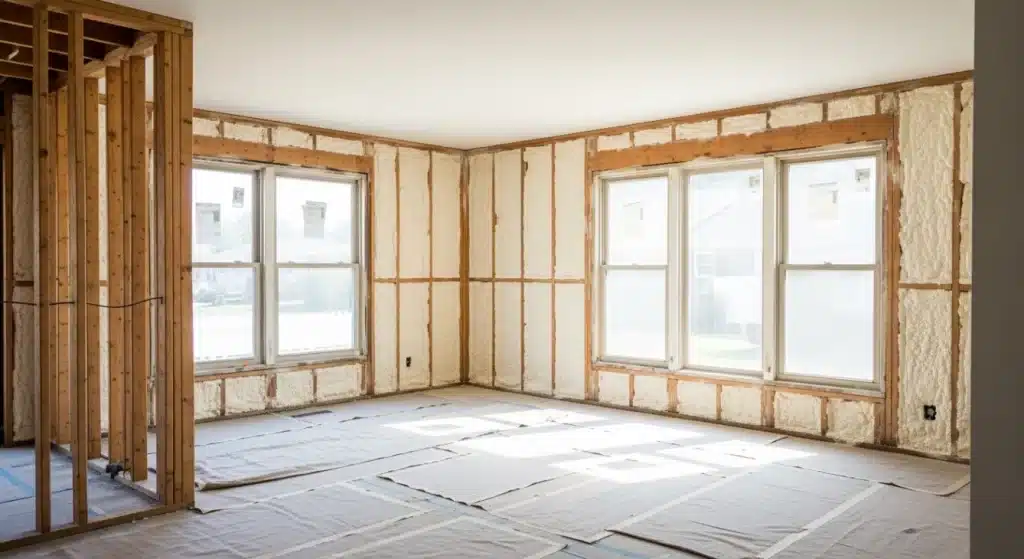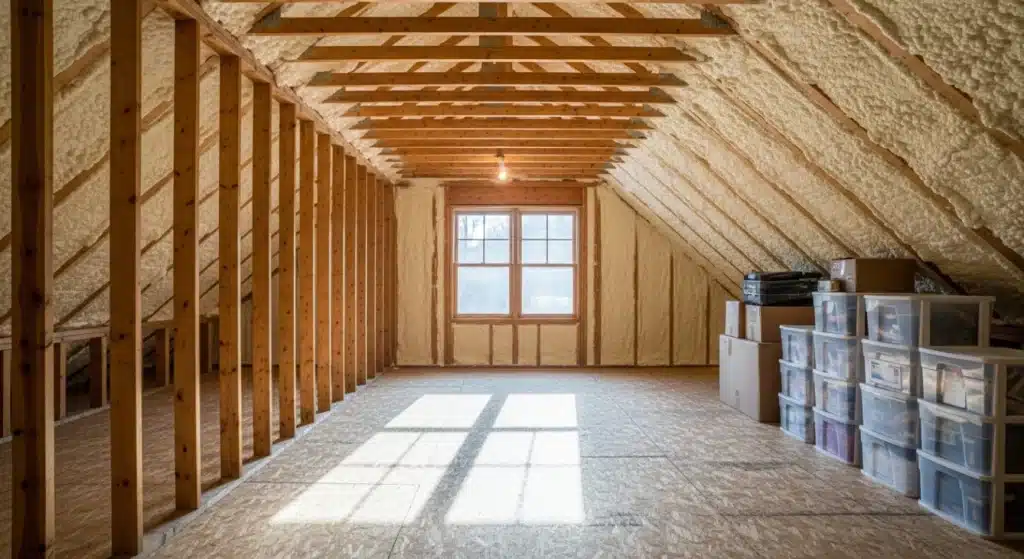Yes, a lack of insulation often causes cold floors in Madera, CA properties. Heat naturally rises, but without proper barriers in floors, it escapes downward, pulling in cooler air from below. In this region’s Central Valley climate, where winter nights drop into the 30s and 40s Fahrenheit, uninsulated floors make rooms feel chilly even when the thermostat reads comfortable. Homeowners notice bare feet getting cold quickly on tile or hardwood surfaces.
This article covers the main causes of cold floors, how insulation fixes the issue, and practical steps to check your property. Readers gain clear facts and tips based on real-world observations from insulation projects in the Fresno area, including Madera. Expect straightforward advice drawn from those experiences, informed by cases handled by Supreme Spray Foam – Fresno, which has spotted patterns pointing to insulation gaps as a key factor.
How Cold Floors Develop
Cold floors start with basic heat transfer. Air inside homes warms up, but floors without insulation let that warmth seep out through slabs or crawl spaces. Concrete slabs, common in Madera homes built after the 1970s, conduct cold from the ground up if no barrier blocks it. Wood-framed floors fare better but still lose efficiency without added layers.
This heat loss is particularly pronounced in Madera due to its unique environmental factors. In the area’s dry, variable weather, soil under homes stays cool year-round. During wet winters, moisture adds to the chill by increasing thermal conductivity. A study from the U.S. Department of Energy notes that uninsulated floors can account for up to 25% of a home’s heat loss in cooler climates, though Central Valley conditions amplify this for slab foundations.
Insulation’s Role in Floor Comfort
Insulation works by trapping air pockets that resist heat flow. For floors, materials like foam or fiberglass create a shield against ground chill. In raised foundations, typical for older Madera properties, adding insulation to joists prevents drafts from creeping up. Slab homes benefit from under-slab barriers during construction, but retrofits use perimeter sealing.
Local building codes in California require R-19 insulation for floors in new construction, according to the California Energy Commission. Yet many pre-1980s homes in Madera fall short, leading to uneven temperatures. Data from the U.S. Census Bureau’s American Housing Survey shows that 40% of California homes built before 1980 lack adequate floor insulation, contributing to higher energy bills.
Bonus Tip: Check for gaps around pipes or vents in floors; these spots often let cold air rush in, worsening the overall chill. Seal them with foam before full insulation. Once insulation is in place, monitoring for ongoing issues becomes key.
Spotting Insulation Shortfalls
Feel the difference? If floors stay icy underfoot while walls feel warm, insulation likely needs attention. Other signs include higher utility bills in winter, condensation on lower cabinets, or drafts near baseboards. In Madera, where fog rolls in from nearby areas, these issues spike during damp spells.
Inspect crawl spaces if your property has one. Bare dirt floors or exposed joists without pink fiberglass rolls signal problems. For slabs, lift a loose tile or check edges for cold spots. Energy audits reveal these issues fast, but simple tests like placing a thermometer on the floor versus air temperature help too.
Floor Insulation Choices
Several options suit Madera properties, each with pros based on home style.
Rigid foam boards work well for slabs, offering high R-value per inch. Fiberglass batts fit between joists in raised floors, easy to install in accessible spaces. Spray foam expands to fill odd shapes, ideal for retrofits around utilities.
Here’s a comparison of common floor insulation types:
| Material | R-Value per Inch | Best For | Installation Notes | Cost Range (per sq ft) |
|---|---|---|---|---|
| Fiberglass Batts | 3-4 | Raised floors | Staple into joists; requires ventilation | $0.50-$1.00 |
| Rigid Foam Boards | 4-6 | Slab edges/perimeter | Cut to fit; use adhesive for slabs | $0.80-$1.50 |
| Spray Foam | 6-7 | Irregular spaces | Professional application; seals air leaks | $1.00-$2.50 |
This table draws from guidelines by the Insulation Institute, helping pick based on your setup. Spray foam stands out for Madera’s occasional humidity, as it blocks moisture better than batts.
Bonus Tip: Measure your floor area first. A 1,000 sq ft home might need 20-30 inches of total insulation depth for R-30, depending on material.
In the Central Valley, opt for materials rated for termite resistance, given local pest activity. Avoid over-insulating without vapor barriers to prevent trapped moisture.

Market Facts on Insulation Impact
For Madera residents, upgrading floor insulation cuts energy use by 10-20% in California homes, per a report from the California Energy Commission. In Madera County, where average winter heating costs hit $150 monthly, this translates to real savings. Nationally, the U.S. Department of Energy reports that proper insulation reduces floor heat loss by 50% or more, easing strain on HVAC systems.
Another fact: Over 30% of Madera homeowners report discomfort from cold floors in surveys by the Pacific Gas and Electric Company, often tied to outdated insulation.
Things to Consider Before Making a Decision
Assess your home’s age and foundation type first. Older Madera properties from the 1950s boom era often have minimal insulation, while post-2000 builds meet stricter codes. Budget plays a role; retrofits cost $1-3 per sq ft, but tax credits through the Inflation Reduction Act cover up to 30% via IRS Form 5695.
Think about long-term plans. If selling soon, focus on high-impact areas like living rooms. For staying put, prioritize whole-home efficiency to lower bills over time. Climate specifics matter too: Madera’s hot summers mean insulation doubles as a summer heat block, keeping slabs from radiating warmth indoors.
Evaluate DIY feasibility. Simple batt installs work for handy folks, but spray foam demands pros to avoid off-gassing or uneven coverage. Check for asbestos in pre-1980s homes before disturbing floors.
Bonus Tip: Get a free energy assessment from PG&E. They spot insulation issues and suggest rebates tailored to Central Valley homes.
Common Questions
Do rugs fix cold floors?
Rugs only cover the problem—they don’t stop heat loss. Proper insulation below the surface is the long-term solution for keeping floors consistently warm.
Does insulation help with noise?
Yes. Floor insulation dampens footsteps and other impact sounds, making multi-story homes quieter and more comfortable for daily living.
Key Takeaways
Lack of insulation directly causes cold floors by allowing heat to escape downward, a common problem in Madera’s climate. Signs like chilly tiles and high bills signal the need for checks. Options range from batts to spray foam, with choices depending on foundation and budget. Consider home age, costs, and local factors before acting; audits help pinpoint needs.
Evaluate your property’s setup against these points. Match solutions to your daily routines and future plans for lasting comfort.
Ready to Address Cold Floors
Take the next step by reaching out for guidance on insulation options suited to Madera properties. Contact Supreme Spray Foam – Fresno at (559) 545-0800 or email [email protected] to discuss your situation. Professionals review specifics and outline practical paths forward without commitment. This ensures decisions fit your home’s unique needs.
Sources
- U.S. Department of Energy – Government resource on home insulation basics, including heat loss percentages for floors.
- California Energy Commission – Official site detailing California’s building codes for insulation, relevant to Madera requirements.
- U.S. Census Bureau American Housing Survey – National data on housing conditions, including insulation prevalence in older California homes.
- Insulation Institute – Industry group providing material comparisons and R-value guides for floor applications.
- Pacific Gas and Electric Company – Utility reports on customer surveys and energy audits in the Central Valley, including Madera.
Frequently Asked Questions About Cold Floors and Insulation
Does insulation fix cold floors in slab homes?
Yes, perimeter and under-slab insulation blocks ground chill effectively. In Madera, where slabs sit on cool soil, this approach warms surfaces by 10-15 degrees without major disruption.
How long does floor insulation last?
Quality installs endure 20-50 years. Fiberglass holds up if dry, while foam resists settling. Regular checks in Madera’s dusty conditions extend life by addressing minor wear.
Can I insulate floors myself?
Basic batts suit DIY in accessible spaces, but measure precisely to avoid gaps. Pros handle spray foam for even coverage, especially around Madera’s common utility penetrations.
Will insulation lower my energy bills?
Expect 5-15% savings on heating in Central Valley winters. Combine with weatherstripping for best results, as drafts amplify cold floor issues.
Is insulation needed in Madera’s mild climate?
Even with average lows around 40°F, uninsulated floors pull heat constantly. Insulation maintains comfort year-round, countering both winter chill and summer heat gain.


